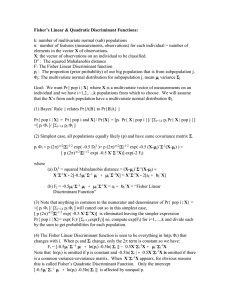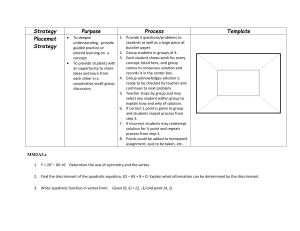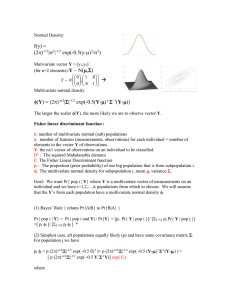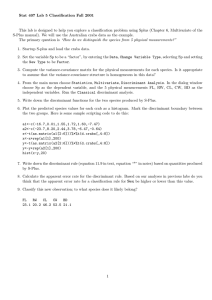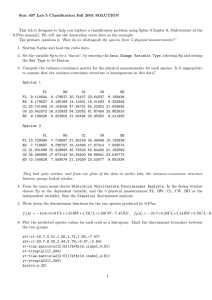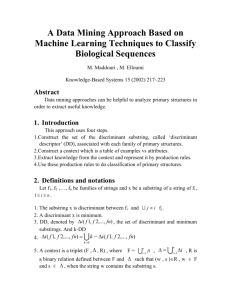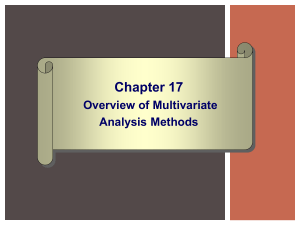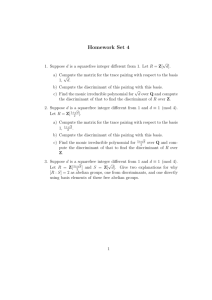Normal Density:
advertisement
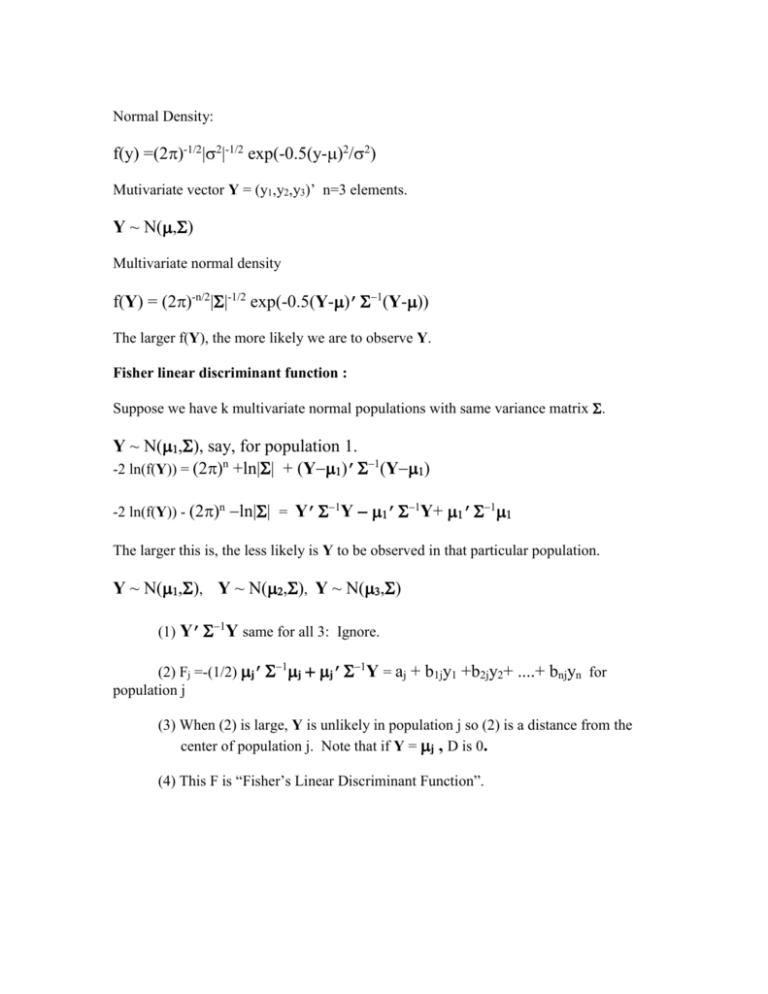
Normal Density:
f(y) =(2)-1/2||-1/2 exp(-0.5(y-)2/2)
Mutivariate vector Y = (y1,y2,y3)’ n=3 elements.
Y ~ N()
Multivariate normal density
f(Y) = (2)-n/2||-1/2 exp(-0.5(Y-)’Y-))
The larger f(Y), the more likely we are to observe Y.
Fisher linear discriminant function :
Suppose we have k multivariate normal populations with same variance matrix .
Y ~ N(), say, for population 1.
-2 ln(f(Y)) = (2)n +ln|| + (Y)’Y)
-2 ln(f(Y)) - (2)n ln|| = Y’Y ’Y+ ’
The larger this is, the less likely is Y to be observed in that particular population.
Y ~ N(), Y ~ N(), Y ~ N()
(1) Y’Y same for all 3: Ignore.
(2) Fj =-(1/2) j’j j’Y = aj + b1jy1 +b2jy2+ ....+ bnjyn for
population j
(3) When (2) is large, Y is unlikely in population j so (2) is a distance from the
center of population j. Note that if Y = j , D is 0.
(4) This F is “Fisher’s Linear Discriminant Function”.
Example:
7.5 7.5 6.25
= 7.5 25 12.5
=
6.25 12.5 31.25
2
2
1
1 0 1
1
1
1
0.05 0.02
0.2
0.05 0.0625 0.015
0.02 0.015 0.042
1
Y 2
3
** Class notes example **;
PROC IML;
S = {2 1 1, 0 4 2, 0 0 5}; S = S*S`;
S = 10*S/8;
IN = inv(S);
m1 = {2,-1,1}; m2 = {-2,0,1}; m3 = {1,-1,1};
print S in m1 m2 m3;
D1 =-0.5*m1`*in*m1||(m1`*IN);
D2 =-0.5*m2`*in*m2||( m2`*IN);
D3 =-0.5*m3`*in*m3||( m3`*IN);
D = D1//D2//D3;
Y = {1,2,3};
discriminant = D*({1}//Y);
print D Y discriminant;
S
7.5
7.5
6.25
IN
7.5 6.25
25
12.5
12.5 31.25
0.2 -0.05
-0.02
-0.05 0.0625 -0.015
-0.02 -0.015
0.042
D
-0.52725
-0.461
-0.19725
M1
M2
M3
2
-1
1
-2
0
1
1
-1
1
Y
0.43
-0.42
0.23
-0.1775
0.085
-0.1275
0.017
0.082
0.037
1
2
3
DISCRIMINANT
-0.40125
-0.465
-0.11125
Y is least far from the third population mean. We showed Fj = -2 ln(fj(Y)) + C where C
is constant across all 3 populations. The pdf of Y in population j is then exp(-(1/2)(Fj –
C)). The ratio of any two of these pdf’s, j vs. k for example, would be
exp(-(1/2)(Fj –Fk) ). Thus if we compute exp( -(1/2)Fj) / [exp( -(1/2)Fk)], these will be
3 probabilities that add to 1 and are in the proper ratio. If we think in Bayesian terms of
equal prior probabilities that an observed vector comes from population j then we have
computed the posterior probability of being from group j given the observed Y.
Now if the variance matrices j differ, then we see that ln|j| is no longer constant and
both ln|j| and Y’jY (a quadratic form) must be re-included in Fj giving Fisher’s
quadratic discriminant analysis.
Finally, if there are non-equal prior probabilities pj for each population then that also
must be accounted for in Fj
